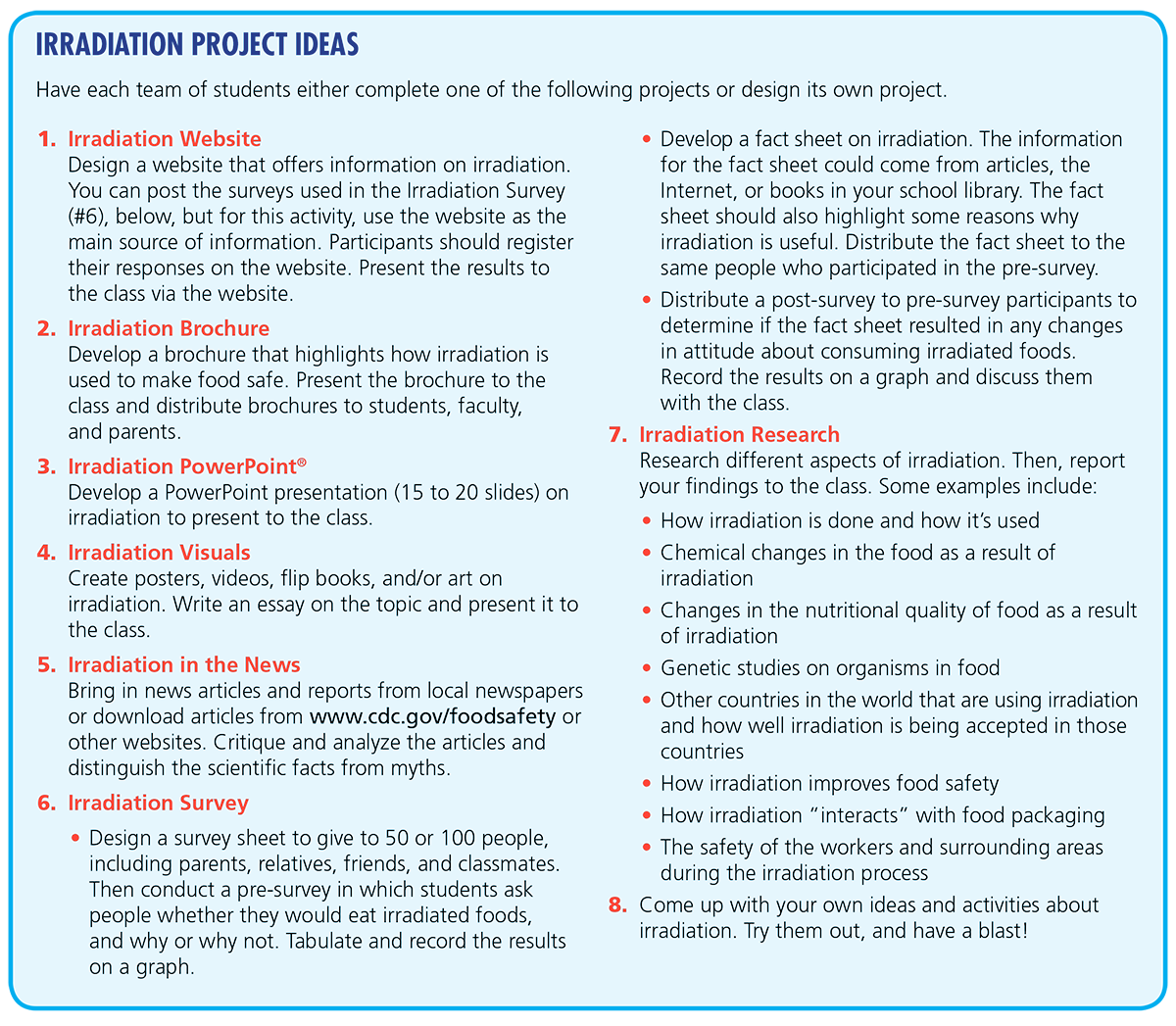 Relevancy and Engagement
newjersey.agclassroom.org
Relevancy and Engagement
newjersey.agclassroom.org
Irradiation Web Quest
This activity introduces students to food irradiation. Students will work in teams to conduct research on irradiation, analyze public opinion, and discover some of the advantages of this process.
Time to Complete
Materials
-
Irradiation Research Questions, 1 per student (attached)
Advance Preparation
- Write each number (1 through 24) on a separate piece of paper. Place the 24 pieces of paper in a bowl.
- Review and write down the answers to the Irradiation Research Questions using the following resources and websites:
Procedures
- Begin this activity with the following discussion:
- "Would you eat irradiated food? If you did, would you glow in the dark? Think of how your friends might react to you when you go to the movies, go for a walk at night, or participate in other nighttime activities." Let the students discuss this for a few minutes.
- The answer is: No, you won’t glow if you eat irradiated food. But there’s a really high probability that either you or your friends have eaten irradiated food. "Can you think of any foods that you eat that may have been irradiated?"
- "Have you ever eaten spices? Do you think they might have been irradiated? If so, would it affect your health?"
- "We’re going to learn about irradiation by doing research using specific resources and websites. You will discover many interesting facts about the irradiation process as you go through all the materials. Then, you’ll have the opportunity to work in teams on some irradiation research projects."
- Divide students into 6 “expert” teams. Then, distribute the Irradiation Research Questions to each student.
- Have each team randomly select 4 numbers from the bowl. These numbers represent the 4 questions from the Irradiation Research Questions that their team will “master.” Students will become the “experts” on these questions and share their knowledge with the rest of the class.
- The teams can conduct their research at the sites listed at the top of the Irradiation Research Questions page. This will be a starting point for getting them interested in the science behind irradiation. It will also give them some basic, credible information they can expand upon as they complete their irradiation projects.
- Ask the entire class these questions based on what they learned during their research:
- "What is irradiation?" (Irradiation is a process of treating food with a measured dose of radiation to kill harmful substances.)
- "What are the advantages of irradiation?" (Irradiation reduces or eliminates pathogenic bacteria, insects, and parasites. It reduces spoilage, and in certain fruits and vegetables, it inhibits sprouting and delays the ripening process. It does not make food radioactive, compromise nutritional quality, or noticeably change food taste, texture, or appearance as long as it’s applied properly to a suitable product.)
- "How do you know irradiation is safe?" (The Food and Drug Administration has evaluated irradiation safety for 50 years and found the process to be safe and effective for many foods.)
- Review the answers to the Irradiation Research Questions in a class discussion.
- Now, the teams are ready to complete one of the projects listed below; or, they can come up with their own ideas. The results of the projects will be shared with the entire class at the conclusion of the activity. Give students a class date for project presentations.
- Note: There’s an abundance of information on irradiation on the Internet. Students can use a search engine, enter “food irradiation,” and they will find many references. There are also many articles that can be found in your local public or school library.

- Note: There’s an abundance of information on irradiation on the Internet. Students can use a search engine, enter “food irradiation,” and they will find many references. There are also many articles that can be found in your local public or school library.
Concept Elaboration and Evaluation
- What does irradiation have to do with NASA? (In space, astronauts eat foods that have been treated by irradiation on earth.)
- "How does irradiation reduce bacteria?" (High-energy electrons or gamma rays are passed through the food. This breaks the DNA in the bacteria and prevents them from replicating, which inactivates or kills the bacteria.)
Summarize with students that irradiation plays a role in reducing the incidence of foodborne illness. This process destroys microorganisms by damaging the DNA in the microbes. The Food and Drug Administration has evaluated irradiation safety for 50 years and found the process to be safe and effective for many foods.
 Note to Teacher
Note to Teacher
This activity is part of a complete module covering food safety. You can find each lesson on the Matrix using the links below or by searching the keywords, "Science and Our Food Supply."
File, Map, or Graphic
Author
Organization
Sources
The Science and Our Food Supply Curriculum was brought to you by the Food and Drug Administration Center for Food Safety and Applied Nutrition and the National Science Teachers Association.
- FDA Education Team Leader Food Safety Initiative: Marjorie L. Davidson
- FDA Science and Our Food Supply Project Director: Louise H. Dickerson
- FDA/NSTA Associate Executive Director and Science and Our Food Supply Program Director: Christina Gorski
- FDA/NSTA Science and Our Food Supply Program Assistant: Jill Heywood